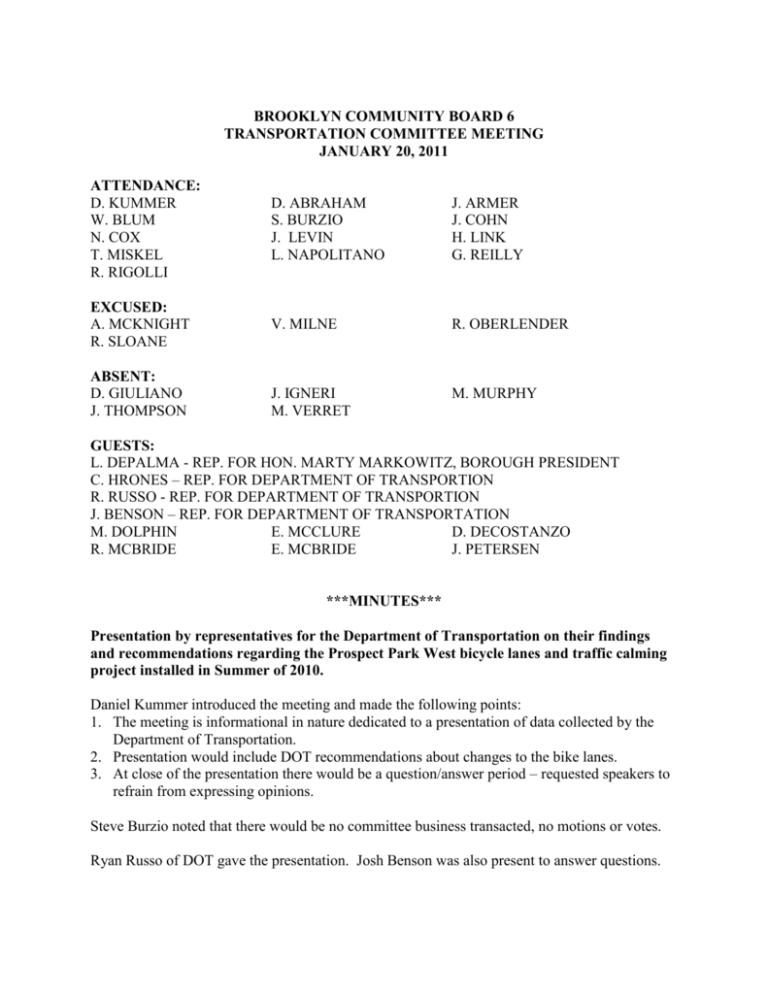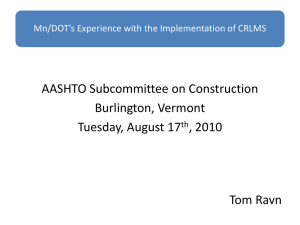Brooklyn Community Board 6
advertisement

BROOKLYN COMMUNITY BOARD 6 TRANSPORTATION COMMITTEE MEETING JANUARY 20, 2011 ATTENDANCE: D. KUMMER W. BLUM N. COX T. MISKEL R. RIGOLLI D. ABRAHAM S. BURZIO J. LEVIN L. NAPOLITANO J. ARMER J. COHN H. LINK G. REILLY EXCUSED: A. MCKNIGHT R. SLOANE V. MILNE R. OBERLENDER J. IGNERI M. VERRET M. MURPHY ABSENT: D. GIULIANO J. THOMPSON GUESTS: L. DEPALMA - REP. FOR HON. MARTY MARKOWITZ, BOROUGH PRESIDENT C. HRONES – REP. FOR DEPARTMENT OF TRANSPORTION R. RUSSO - REP. FOR DEPARTMENT OF TRANSPORTION J. BENSON – REP. FOR DEPARTMENT OF TRANSPORTATION M. DOLPHIN E. MCCLURE D. DECOSTANZO R. MCBRIDE E. MCBRIDE J. PETERSEN ***MINUTES*** Presentation by representatives for the Department of Transportation on their findings and recommendations regarding the Prospect Park West bicycle lanes and traffic calming project installed in Summer of 2010. Daniel Kummer introduced the meeting and made the following points: 1. The meeting is informational in nature dedicated to a presentation of data collected by the Department of Transportation. 2. Presentation would include DOT recommendations about changes to the bike lanes. 3. At close of the presentation there would be a question/answer period – requested speakers to refrain from expressing opinions. Steve Burzio noted that there would be no committee business transacted, no motions or votes. Ryan Russo of DOT gave the presentation. Josh Benson was also present to answer questions. Ryan noted that the presentation was also available on the DOT website. Highlights from the presentation: 1. Project constructed June 2010. 2. Post construction some minor changes were made – mostly curb regulations and plastic barriers installed at pedestrian islands. 3. Bicycle count results: a. 190% increase in cyclist volume weekdays. Cyclists on sidewalk declined from 46% to 3%. b. 125% increase in cyclist volume weekends. Cyclists on sidewalk declined from 20% to 4%. 4. Traffic speed results: a. Before project 75% of vehicles broke speed limit; after 20% of vehicles did. b. Average vehicle speeds declined from 33.8 mph to 26.6 mph. 5. Traffic volume results: a. Traffic volumes remained nearly unchanged: increasing about 5% on Carroll St and decreasing on 11th Street. b. Both bicycle and vehicle volume increased on PPW - +13% in AM rush and +9% in PM rush. The change was attributed to retiming the lights to make them a more ‘normal’ progression. The lights had previously been timed to discourage speeding. Side street light timing was reduced slightly. 6. Travel time results: a. Travel times remained essentially unchanged on 6th, 7th, 8th Avenues and PPW. 7. Safety results: a. Crashes declined 16%. b. Crashes with injuries declined 63%. c. No reported injuries to pedestrians. d. No reported injuries due to bike-pedestrian crashes. 8. Suggested revisions in response to community input: a. Raised pedestrian islands with landscaping. Will provide better view of traffic and eliminate parking in the pedestrian zone. b. Rumble strips on the bike path to alert cyclists to pedestrian crossings. c. Narrow the buffer between Union and Montgomery. d. Redesign 9th Street loading zone. Question and answers: Q – Why are there no ‘no parking’ spaces that handicapped persons can use near 9th Street? A – Upgrades were made to ‘no standing’ because the loading zones were being used and blocked by cars with disability permits. Q – Is DOT working on a timeline to make the bike lanes permanent? A – The project was done at the request of the community. Adjustments will be made as needed and in response to community input. Q – Less speeding noticed on side streets – will DOT look at spillover effects? A – Probably coincidental. No plan to do such a study. Q – Was it a deliberated decision to relocate park bicycle traffic to the street and did DOT measure the difference in bicycle volume between park and street? A – There is strong demand for cycling out of the park because of the more convenient access to the side streets. The two systems serve different types of demand. There is no data on effect of bike lanes on in-park volume. Q – Are rumble strips a hazard for children? A – They are the same material as striping – only a slight thickness. No hazard. Q – At loading zone at GAP there is no turnover – can we get change in signage and enforcement? We believe that DOT data includes a rainy day - wouldn’t that skew the data? A – Re loading zone: signage will be made clearer; we could upgrade to a more restrictive control. Re. rainy day count: DOT policy is that all counts are made during clear weather; we will have to check the data. Q – How does one contact DOT regarding suggested changes to the bike lanes? A – Call 311, go to DOT website, contact DOT office in boro, contact elected officials, contact Community Board. Q – Doesn’t DOT data from 2007, 2008, 2009 show lower accident rates? Will DOT release ‘raw’ data? A – DOT will work with the Community Board and give them access to our data. We can’t really release ‘raw’ data. Q – Regarding volume studies, was there an increase in pedestrian volume? A – Pedestrian volume is too volatile to return statistically useful numbers. Q – How does Park Slope compare to other neighborhoods with regard to safety? A – Generally safer, but DOT normally compares street to street, not neighborhoods. PPW is generally safer because there are no cross streets. Q – Did DOT do the surveys and collect data or a 3rd party? A – Consultants did the data collection. Q – Was impact on emergency response time studied? A – No metric for that. NYPD and FDNY supported the project. Unlikely to be a negative impact since travel times and volume were largely unchanged. Q – Would the entire buffer be raised? A – No – that would interfere with drainage. Raised area limited to signalized intersections. Q – Will long raised islands drain properly? A – DOT engineers will review and design each condition to ensure proper drainage. Q – Did study monitor the park drives? A – No, since there was no significant decrease in PPW volume, it is assumed that park drive volume remained about the same. Q – Was there any study of users? Where they are coming from and going? A – No, DOT performed counts, not surveys. That would require intercept surveys, interviews. Q – Is this bikeway permanent? Wasn’t it presented as an ‘experiment’? A – Community Board made the request for the bike lanes. DOT’s mandate is to promote safety and efficiency. DOT designed the plan, evaluated and monitored it after construction. The project is a success based on the standards established for it, therefore no plans to change it other than adjustments presented. Q – Why was the community led to believe this was a ‘pilot’ project? A – DOT has communicated the purposes of this project very clearly via a public process and has implemented the project in accordance with their standards. Q – How did DOT decide what data to collect? Where can one communicate ideas for data to be collected? A – DOT is open to suggestions; contacts as mentioned previously. Note that there are budget restraints for data collection. Q – If this was an experiment, what are DOT’s conclusions? A – The project is working well, requires some adjustments. Q – What is the cost of the project? In this economy was it worthwhile? A – It was a very inexpensive project: approx $300K. DOT would like to minimize ‘soft’ costs such as surveys. Q – Who funded the project: city or Federal gov? A – 80% funds came from Federal government, 20% from city. Q – What would be the cost to remove it? A – Probably about 3x more than the construction cost. Very difficult to remove the thermoplastic marking paint. Federal funds only available for new installations. Removal cost would be entirely the city’s. Q – Your data doesn’t match data we collected independently and we filed a FOIL request. Why hasn’t the information been turned over? A – The data seems to be from different locations. Weekday trips were a different route, not captured at GAP. The FOIL request arrived before the end of the evaluation period. The data is being compiled and will be sent. Q – (Steve Levin) Is the narrower street a concern during a snow event? A – PPW is 38’ and 4 lanes. No problem to clear the street and leave 2 lanes. Comments by Brad Lander: 1. Reminding community that BL asked DOT commissioner to outline the study last fall. 2. Feels that the data shows the success of the project. 3. Noted that the Community Board had asked for the pedestrian islands originally. 4. Wants the community to continue to comment and to work out shortcomings of the plan. 5. DOT should revisit the loading/parking issues. Q – Were there any environmentally friendly initiatives in the project? A – Besides increased use of bicycles, traffic efficiency is a major environmental benefit. Constant speed uses less fuel than stop-start. Q – Any analysis showing increased cruising for parking spaces? Are there visibility issues with trees in the pedestrian islands? A – Not much evidence of increased cruising, DOT believes that lost parking spaces were somewhat offset by spaces made available from closed bus stops. Trees will be limbed per city policy so as to maintain visibility. Q – How does increase in numbers of children using bike lanes compare with other bike lanes? A – No data but probably somewhat better than other bike lanes due to the demographics of the neighborhood. Minutes by Norman Cox





